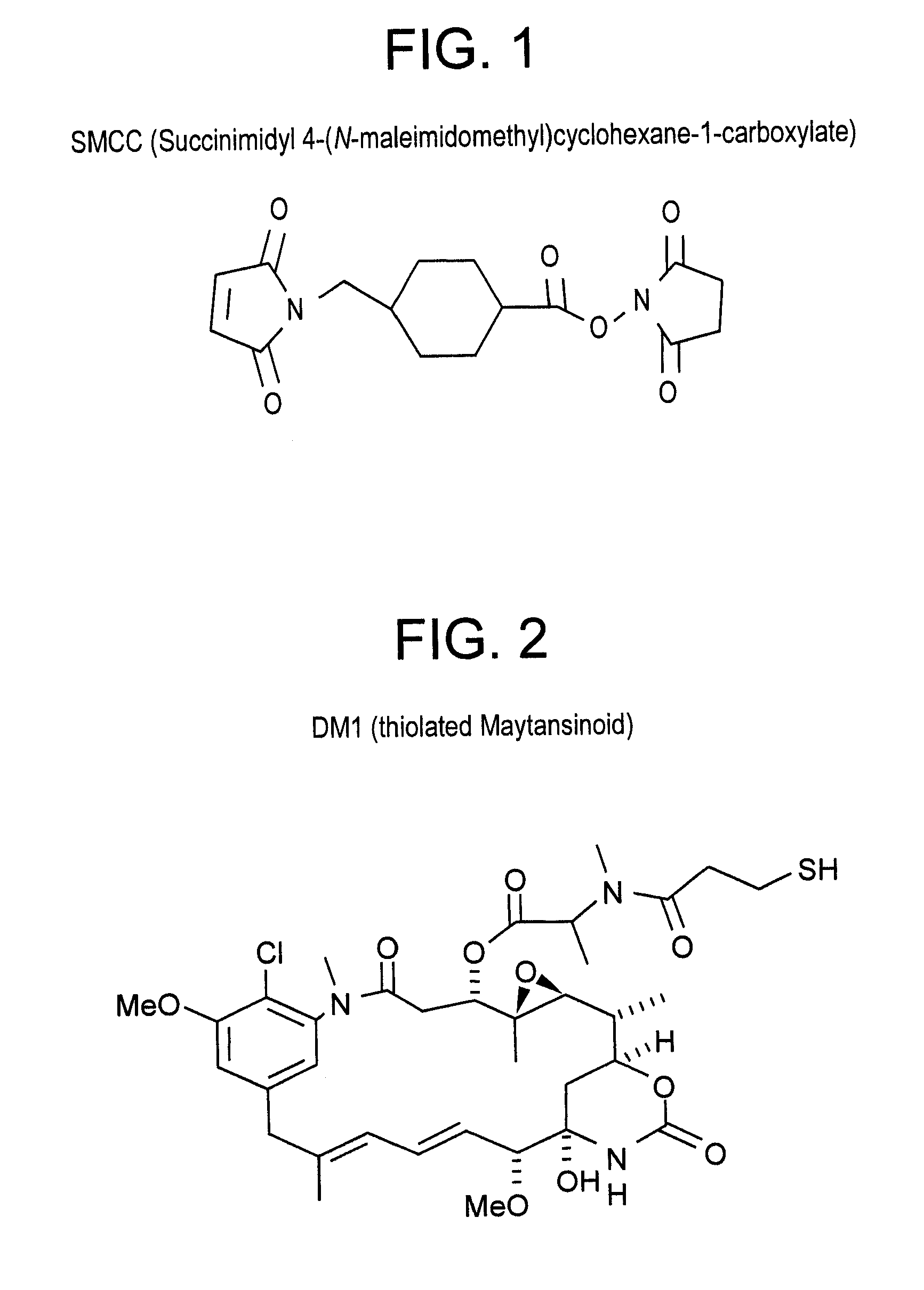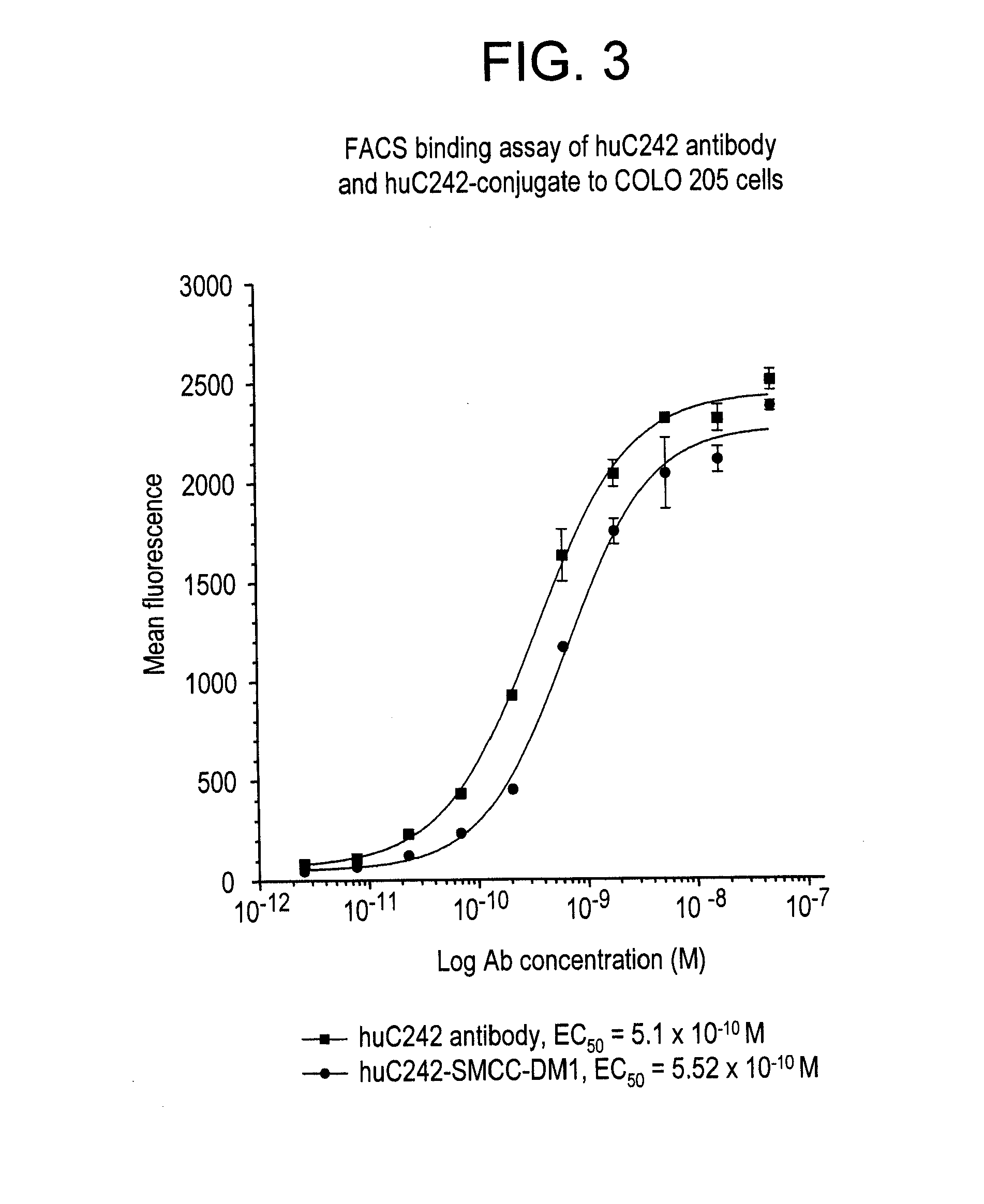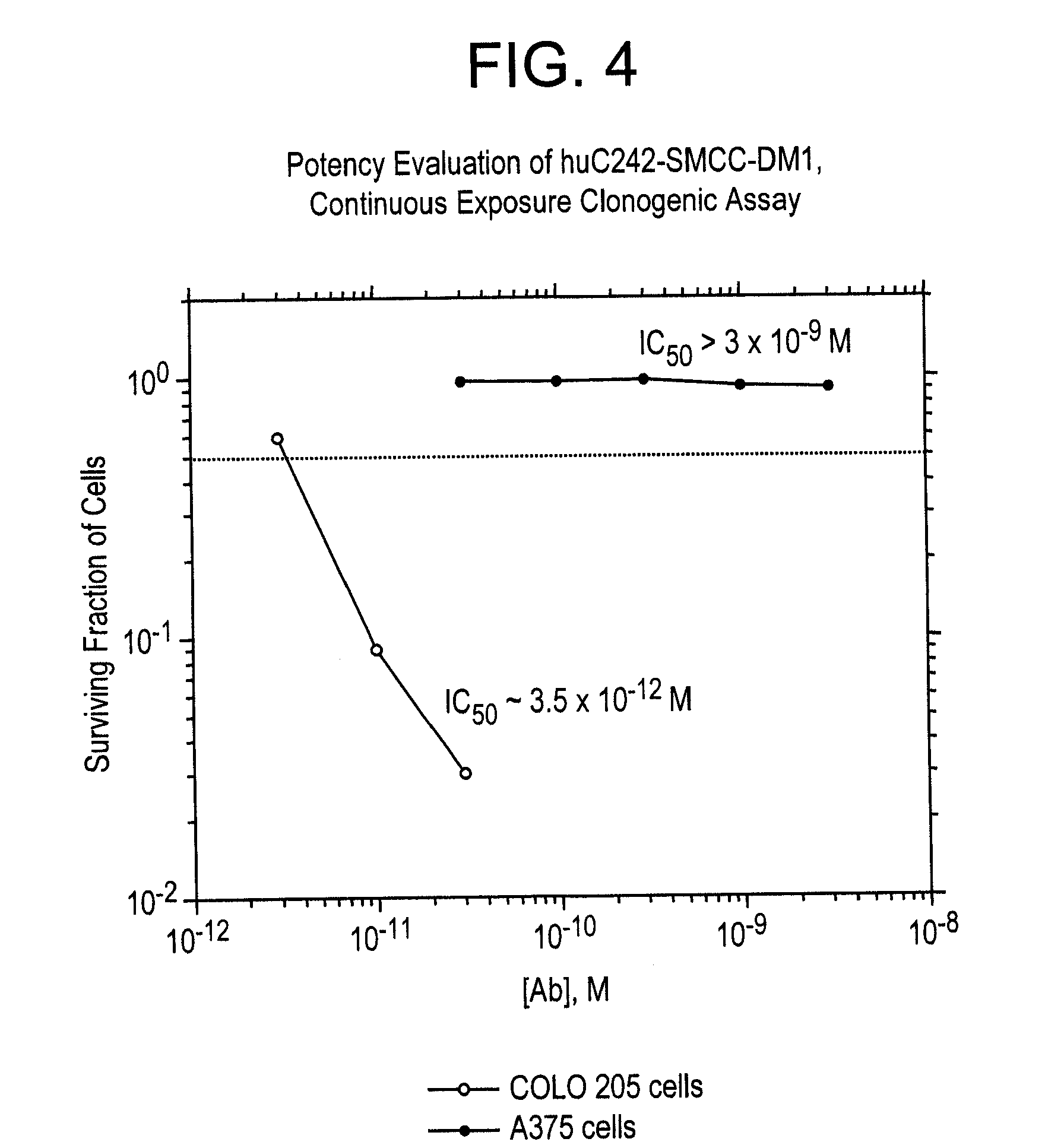Method of targeting specific cell populations using cell-binding agent maytansinoid conjugates linked via a non-cleavable linker, said conjugates and methods of making said conjugates
a cell-binding agent and specific cell technology, applied in the field of specific cell populations targeting using cell-binding agent maytansinoid conjugates linked via non-cleavable linkers, can solve the problems of rare cytotoxic potency of antibody-drug conjugates and experimental data demonstrating the effectiveness of such conjugates
- Summary
- Abstract
- Description
- Claims
- Application Information
AI Technical Summary
Benefits of technology
Problems solved by technology
Method used
Image
Examples
example 1a
Preparation of huC242-SMCC-DM1 Conjugate
[0223]a. Preparation and Measurement of huC242 Antibody
[0224]The concentration of antibody was measured using an extinction coefficient of 1.48 (mg / mL)−1 at 280 nm and a molecular weight of 147,000 g / mole.
b. Preparation and Measurement of SMCC Stock Solution
[0225]A 20 mM solution of SMCC (6.69 mg / mL) was prepared in dimethylsulfoxide (DMSO). The solution was diluted 1 / 40 in Assay Buffer and the absorbance of the samples measured at 302 nm. The concentration of the stock solution was calculated using an extinction coefficient of 602 M−1 cm−1.
c. Preparation and Measurement of DM1 Stock Solution
[0226]A 10 mM solution of DM1 (free thiol form) was prepared in dimethylacetamide (DMA) (7.37 mg / mL) (FIG. 2). The absorbance of dilutions of the stock solution in ethanol (EtOH) was measured at 280 nm. The concentration of stock DM1 was calculated by using an extinction coefficient of 5700 M−1 at 280 nm. The concentration of free sulfhydryl or thiol group...
example 1b
In vitro Testing of huC242-SMCC-DM1
[0231]a. Binding
[0232]The binding affinities of huC242 antibody and huC242-SMCC-DM1 were compared using an indirect method on COLO 205 cells, where 5×103 cells per well were used, with three hour primary incubation on ice. The results are shown in FIG. 3. The naked antibody bound with a KD of 5.1×10−10 M and the conjugated version bound with a KD of 5.52×10 M. Thus, conjugation with DM1 does not appear to alter the binding affinity of huC242.
b. Cytotoxicity and Specificity
[0233]The in vitro cytotoxicity and specificity of the huC242-SMCC-DM1 conjugate were evaluated using a continuous exposure clonogenic assay. The results are shown in FIG. 4. HuC242-SMCC-DM1 was effective in destroying the antigen-positive SKBR3 cells (IC50=3.5×10−12 M). Specificity was shown by comparing the IC50 value of the target SKBR3 cells to that of the antigen-negative cell line, A375, in which the IC50 of the conjugate was greater than 3.0×10−9 M.
c. Size Exclusion Chromat...
example 2a
Preparation of Trastuzumab-Smcc-Dm1 Conjugate
[0236]Trastuzumab antibody was obtained from Genentech for conjugation to DM1 using the non-cleavable heterobifunctional cross-linking reagent SMCC. The antibody was buffer-exchanged from 50 mM potassium phosphate / 2 mM EDTA, pH 6.0 into 50 mM potassium phosphate / 50 mM sodium chloride / 2 mM EDTA, pH 6.5 (Buffer A). The antibody was then reacted with 7.5-fold molar excess SMCC linker and purified by Sephadex G25 resin before it was conjugated with DM1. The final conjugate was again purified by Sephadex G25 resin. The resulting conjugate contained 3.1 moles of DM1 per mole of antibody.
a. Preparation and Measurement of Trastuzumab Antibody
[0237]Trastuzumab antibody in 50 mM potassium phosphate / 2 mM EDTA, pH 6.0 buffer was passed over a Sephadex G25 column equilibrated with Buffer A and eluted into Buffer
A. All buffers used in this experiment were tested to be free of endotoxin using a chromogenic Lymulus amoebocyte lysate (LAL) method (Cambrex...
PUM
| Property | Measurement | Unit |
|---|---|---|
| concentrations | aaaaa | aaaaa |
| plasma clearance | aaaaa | aaaaa |
| durability | aaaaa | aaaaa |
Abstract
Description
Claims
Application Information
 Login to View More
Login to View More - R&D
- Intellectual Property
- Life Sciences
- Materials
- Tech Scout
- Unparalleled Data Quality
- Higher Quality Content
- 60% Fewer Hallucinations
Browse by: Latest US Patents, China's latest patents, Technical Efficacy Thesaurus, Application Domain, Technology Topic, Popular Technical Reports.
© 2025 PatSnap. All rights reserved.Legal|Privacy policy|Modern Slavery Act Transparency Statement|Sitemap|About US| Contact US: help@patsnap.com



